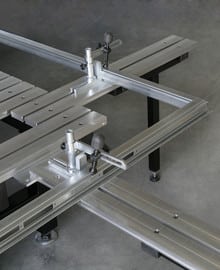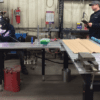There are various types of welding tables available for a wide range of jobs that utilize a variety of different metals. Important elements to consider are the material the top is made of, and the design of the table.
The most popular tops for welding tables in professional workshops are carbon steel and several aluminum alloys. Your choice will depend on the metal (or metals) you and your employees will be working with. If you are working with carbon steels (including mild steel that, by definition contains between 0,15 and 0,35 percent carbon) then a carbon steel top is ideal. But if you are working with stainless steel, a welding table with an aluminum-copper alloy top will be a much better option. If you work with both types of metal, it’s best to have designated tables with a suitable top for each.
carbon steel and several aluminum alloys. Your choice will depend on the metal (or metals) you and your employees will be working with. If you are working with carbon steels (including mild steel that, by definition contains between 0,15 and 0,35 percent carbon) then a carbon steel top is ideal. But if you are working with stainless steel, a welding table with an aluminum-copper alloy top will be a much better option. If you work with both types of metal, it’s best to have designated tables with a suitable top for each.
There are different types of stainless steel, but one thing they have in common is a percentage of the metal element chromium, that gives the metal its shiny appearance and prevents it from rusting. To be classified as stainless steel, metal must contain at least 10 percent chromium, but it often contains more.
Even though you can use the same welding processes when working with carbon steel and stainless steel, the latter is a lot more difficult to work with than carbon steels and it is a lot more expensive, largely because of its chromium content.
Aluminum and copper are both soft, non-ferrous metals. An aluminum-copper alloy is non-ferritic (containing no iron), yet sufficiently hard to form a safe surface or base for the professional processing and welding of stainless steel.
Benefits of Using an Aluminum-Copper Welding Table for Stainless Steel
For quality stainless steel processing it is essential that all ferritic materials are avoided. If a ferritic material like carbon steel is used, any scratches on the surface of the welding table, or adhesion to the stainless steel work piece, can cause corrosion and pitting.
A suitable aluminum-copper alloy will have high tensile strength, with a low surface hardness that won’t cause any ferritic scratches or pitting. Additionally, the surface has high thermal conductivity that prevents spatter from attaching to the welding table surface, and potentially risking damage to the work piece.
A good quality aluminum-copper alloy welding table will incorporate the best possible design features, including a clamping system and rails that are also non-ferritic.
Design Features to Look for When Buying Aluminum-Copper Alloy Welding Tables
All Forster welding tables feature T-slot tops that allow for 3D positioning and clamping of work pieces. This means that the table surface is only partially covered and parts of the work piece can be positioned so that they stick out of the otherwise vertical surface, enabling welders to access critical areas and every possible angle on the work piece. Not only does this make the working process easier and quicker, but fewer clamping elements are needed, and T-slot positions are further protected from welding spatter.
The best designs incorporate modular rails that are interchangeable and enable welders to work with absolute accuracy and produce the best quality work possible. Clamping plungers are made of bronze (which is also a copper alloy) and additional clamping elements and accessories, including copper rails, are available to extend and reinforce structures.
Contact us online or via email for more information about Forster welding tables for quality stainless steel welding.


